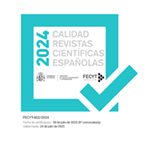Journalists in Spanish cinema: heroes committed to the truth
Abstract
Journalists committed to the search for truth and justice also have a prominent place in Spanish cinema from the 40s to the 21st century. Stories based on novels with brave informants such as La verdad sobre el caso Savolta (Antonio Drove, 1979) or Comanche Territory (Gerardo Herrero, 1997) or attempts to recover episodes from recent history such as Yoyes, (Helena Taberna, 2000), GAL ( Miguel Courtois, 2006) or 23-F (Chema de la Peña, 2011) place film journalists on the side of the heroes of society. The newspaper sends on the radio and television on the big screen, the drama takes the weight although in recent years shares prominence with the thriller and equality between men and women is achieved from the 90s. The contribution of this study is in the recovery of the work Morphology of the story, by the Russian author of structuralism Vladimir Propp, to establish some functions of the journalist after the analysis of 135 films from 1942 to 2012.
Downloads
Article download
License
In order to support the global exchange of knowledge, the journal Estudios sobre el Mensaje Periodístico is allowing unrestricted access to its content as from its publication in this electronic edition, and as such it is an open-access journal. The originals published in this journal are the property of the Complutense University of Madrid and any reproduction thereof in full or in part must cite the source. All content is distributed under a Creative Commons Attribution 4.0 use and distribution licence (CC BY 4.0). This circumstance must be expressly stated in these terms where necessary. You can view the summary and the complete legal text of the licence.










